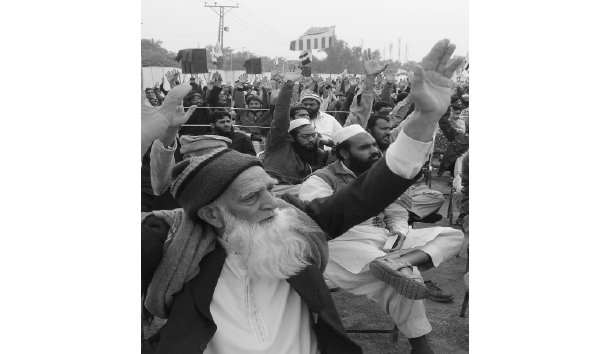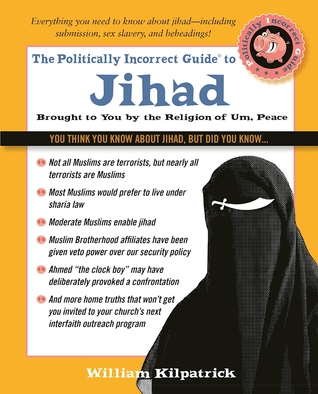On December 7, 2015—Pearl Harbor Day—candidate Donald Trump called “for a total and complete shutdown of Muslims entering the United States until our country’s representatives can figure out what the hell is going on.” After applause from the large crowd at a campaign rally in Mt. Pleasant, South Carolina, Trump emphasized, “We have no choice. We have no choice. We have no choice.”
The statement came five days after jihadists in San Bernardino murdered 14 people and wounded 22. Liberals insisted Trump’s “bigotry” and “Islamophobia” would doom his campaign. Eleven months and a day later, voters proved them wrong.
As to figuring “out what the hell is going on,” a good place to start is The Politically Incorrect Guide to Jihad, by William Kilpatrick, who has written numerous articles on Islam and other topics, as well as 2012’s Christianity, Islam, and Atheism: The Struggle for the Soul of the West.
“The resurgence of Islam is the biggest story of our time,” Kilpatrick declares.
And the primary means by which Islam expands is jihad. Yet few people understand jihad because a politically correct fog has shrouded the topic from honest discussion. That makes the story of Islamic jihad not only a big story, but also one that’s never been fully told.
Jihad has occasionally been described as something akin to Christian mortification of the flesh. After all, Muslims fast during Ramadan. Kilpatrick calls this a “delusion,” and many in the West
have swallowed the establishment line that jihad violence has nothing to do with Islam. Still others cling to the notion that our real enemy is not Islamic jihad but a mysterious global outbreak of “violent extremism.”
He has a point there. U.S. military actions in the Middle East have been used as excuses for jihad killings, including by the San Bernardino couple and the jihadist who killed 49 people on June 12, 2016, in a homosexual nightclub in Orlando. Yet, despite a past tradition of religiously tinged kamikaze bombings, we don’t see Japanese-Americans committing mass atrocities because of Hiroshima or the continued occupation of Okinawa. They didn’t even protest the samurai parody by the late comedian John Belushi.
By contrast, jihad killings are an ongoing, global phenomenon. Kilpatrick details numerous attacks. In addition to such better-known attacks as those made on Charlie Hebdo in 2015 and in Nice in 2016,
On March 1, 2014, a group of knife-wielding Islamic terrorists burst into the Kunming train station in Southern China, killing thirty people and injuring more than one hundred.
In December 2013, an Islamic jihadist group claimed responsibility for twin suicide bombing attacks in Volgograd—one at a railroad station, the other aboard a trolley—which resulted in at least thirty-four deaths. . . .
More than 180 people were killed and 700 injured in Mumbai in July 2006, when Muslim terrorists attacked the train system.
So, why do Muslims practice violent jihad? It began with Muhammad, who “is considered by Muslims to be the most perfect man who ever lived—a man whose life is held up as a model for Muslims to imitate in every detail.” Some apologists for Islam insist atrocities are un-Islamic. But Kilpatrick points out that Muhammad “permitted rape and sex slavery.” And
He ordered the beheading of all the men of the captured Banu Qurayza [Jewish] tribe and the enslavement of the women and children. According to some accounts, between eight and nine hundred men and adolescent boys were executed as Muhammad and his child bride looked on.
Koran 2:191 says, “And kill them wherever you find them, and turn them out from where they have turned you out.” And Koran 8:39: “And fight with them until there is no more fitna (disorder, unbelief) and religion is all for Allah.” There are many similar passages.
It’s true that Christians sometimes committed atrocities against pagans, but the founder of the religion, Jesus Christ, killed no one and indeed was crucified. Today, no Christian denomination, except possibly tiny splinter groups, advocates using violence to convert anyone.
When Muslims take over a state, they impose sharia. Christians and Jews are tolerated as “peoples of the book” if they submit and become dhimmis. “Unfortunately, the dhimmi laws are not a thing of the past,” Kilpatrick writes. “Churches are prohibited in Saudi Arabia, and Christian visitors to the Kingdom are not allowed to bring Bibles with them.” (During the 2016 presidential campaign, news reports disclosed that the Saudis had contributed up to $25 million to the Clinton Foundation.) “In Iraq and Syria,” Kilpatrick writes, “the Islamic State has re-imposed the jizya tax and Islamic Scholars cite the Koran and the Pact of Omar as justification for doing so.” I would add that the latter resulted from the disastrous American wars against the secularist regimes in Iraq and Syria, which had protected their Christian minorities.
The book includes four chapters on “Jihad Without Bombs.” The purpose of this sort of jihad is to take over societies through immigration. In mentioning that very real threat, Kilpatrick criticizes “conservatives and Christians as diverse as Dinesh D’Souza, E. Michael Jones, and Timothy Cardinal Dolan [who] have emphasized the common moral ground shared by Catholics and Muslims.” I have to disagree somewhat here. I remember the 1994 International Conference on Population and Development in Cairo, when Pope John Paul II rallied Christian and Muslim countries to defeat the globalist antipopulation agenda of President Bill Clinton and his wife. That forced Vice President Al Gore to insist, just before the conference, that “the U.S. has not sought, does not seek, and will not seek to establish any international right to abortion.”
There’s a difference between necessary cooperation with Islamic governments against globalists and opening our borders to jihadis. And it’s the globalists, not the jihadis, who opened our borders.
Kilpatrick writes of “Strategies to Defeat Jihad.” One strategy is to restore our military and “ground our terrorism strategy in reality, not fantasy.” But the real problem, as William Lind has detailed in his writings on Fourth Generation Warfare, is that we have stupidly destroyed states throughout the Middle East and surrounding areas, and jihadists have filled the vacuum. As for ISIS, Trump and Russian President Vladimir Putin seem to be working already on a coordinated strategy to destroy it.
Another of Kilpatrick’s strategies is to bring down “the price of oil with fracking and nuclear power.” But the price of oil depends on a vast global market that cannot be influenced by any single government—even the United States—except through counterproductive currency manipulations. After September 11, Fed chairmen Alan Greenspan and Ben Bernanke foolishly inflated the dollar, causing gold to rise in value from $255 per ounce in 2001 to upward of $1,400 by 2011. That pushed the price of oil from below $10 per barrel to more than $100, a great help to the Saudis in funding global jihad (and to ISIS, as WikiLeaks has revealed).
During the same period, global wheat prices more than quadrupled, causing food shortages in Egypt, Syria, and other low-oil countries and sparking the unrest that has since plagued them, also encouraging jihad.
In the long term, there are two essential strategies that are necessary to roll back jihad in America. First, we must reverse our de facto policy of “invade the world, invite the world.” Leave the people of Islamic countries alone—and don’t allow them to come here. We need another lengthy immigration pause, like the one between 1924 and 1965. Noncitizens whose visas have expired ought to be returned to their homelands.
Second, we must earnestly seek to convert Muslims to the real Jesus—not merely a prophet, but the Son of God, the Second Person of the Holy Trinity. Kilpatrick urges that, if exposing the real
Muhammad is the key to casting doubts about Islam, Jesus of Nazareth provides the path out of Islam. The penalty for converting away from Islam is death, so it takes a fairly compelling reason to convert, such as Jesus himself.
Kilpatrick concludes on a note of hope: “According to various reports, a surprisingly high percentage of Muslim conversions to Christianity result from a dream or vision of Jesus—the Christian Jesus, that is.”

[The Politically Incorrect Guide to Jihad, by William Kilpatrick (Washington, D.C.: Regnery Publishing) 203 pp., $21.99]

Leave a Reply